Bluetti and EcoFlow are two major brands in the portable solar power industry. Famed for producing battery stations that are both dependable and lasting, a power station from either brand should be a great buy.
To help you pick the ideal product for your needs, this comparison article should come in handy. I have compared the brands directly, then gone further to analyze individual products.
And since I’ve covered multiple price ranges, that should make it easier to make your pick.
Update: Ecoflow recently released a new product called Delta 2 which is both cheaper and more efficient than their Delta model
Brand comparison: Bluetti vs Ecoflow
As mentioned before, either brand is a good pick. But there are some distinctions.
Bluetti
Founded in 2019, this Las Vegas startup has everything you need from solar generators to power banks. Despite being a newcomer in the industry, the brand boasts successful products and the reviews depict this.
What is more, Bluetti’s solar generators are feature-rich, with expansion options and lots of practical accessories to choose from (see the whole catalog here).
Bluetti products are widely popular for their affordability. They have tens of thousands of reviews on Amazon. All of their products are available on their official website and most of the products are on Amazon store and many other popular retailers like Home Depot, Lowes too.
EcoFlow
EcoFlow entered the portable power stations market in 2017, thanks to a group of battery engineers. Like Bluetti, various factors make EcoFlow stand out. The most notable, however, are unrivaled charging speeds, impeccable customer service, and great adaptability.
In most categories, EcoFlow outperforms Bluetti if portability, adaptability, and rapid charging are your main concerns. Ecoflow has a variety of batteries to choose from. They even have a whole-home unit now. View their entire catalog here.
Ecoflow products are popular for their cool features, durability and aesthetics. Their products are on EF official site, Amazon, Wellbots and a bunch of other local & online retailers.
I’ve heard Ecoflow’s customer support is great. Their products are very reliable and built strong.
With brand comparison out of the way, it’s time to have a quick peek at the products that I have compared in this article:
At a glance,
I’ve broken down the comparisons using the following criteria:
- Package content (what’s in the box)
- First impressions
- Portability
- Battery capacity & power
- Recharge times
I’ve also included a verdict at the end of every comparison, highlighting the best product for specific needs. So be sure to read that part too.
Time to dive in!
1. Ecoflow River 2 vs. Bluetti EB3A – Entry level (priced around $200)
If you’re looking to save some money, you’ll find River 2 and EB3A to be very attractive. Both of these power stations are suitable for light power needs.
| PREVIEW | PRODUCT | |
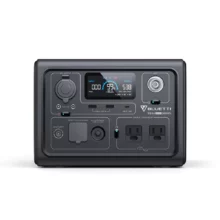
|
Bluetti EB3A | See on Bluetti |
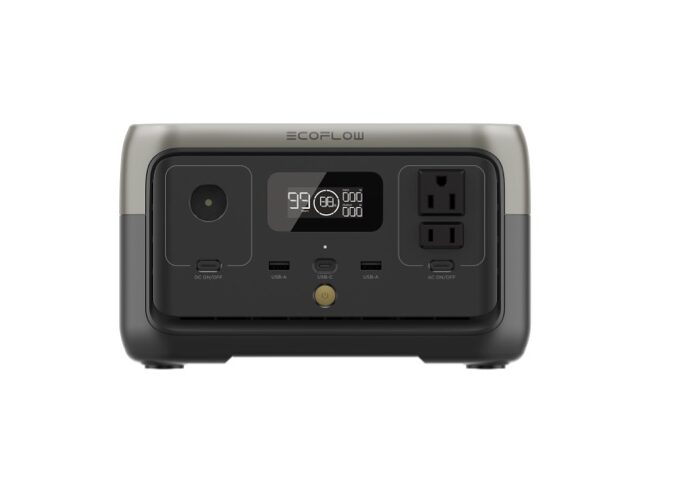 |
Ecoflow River 2 | See on Ecoflow |
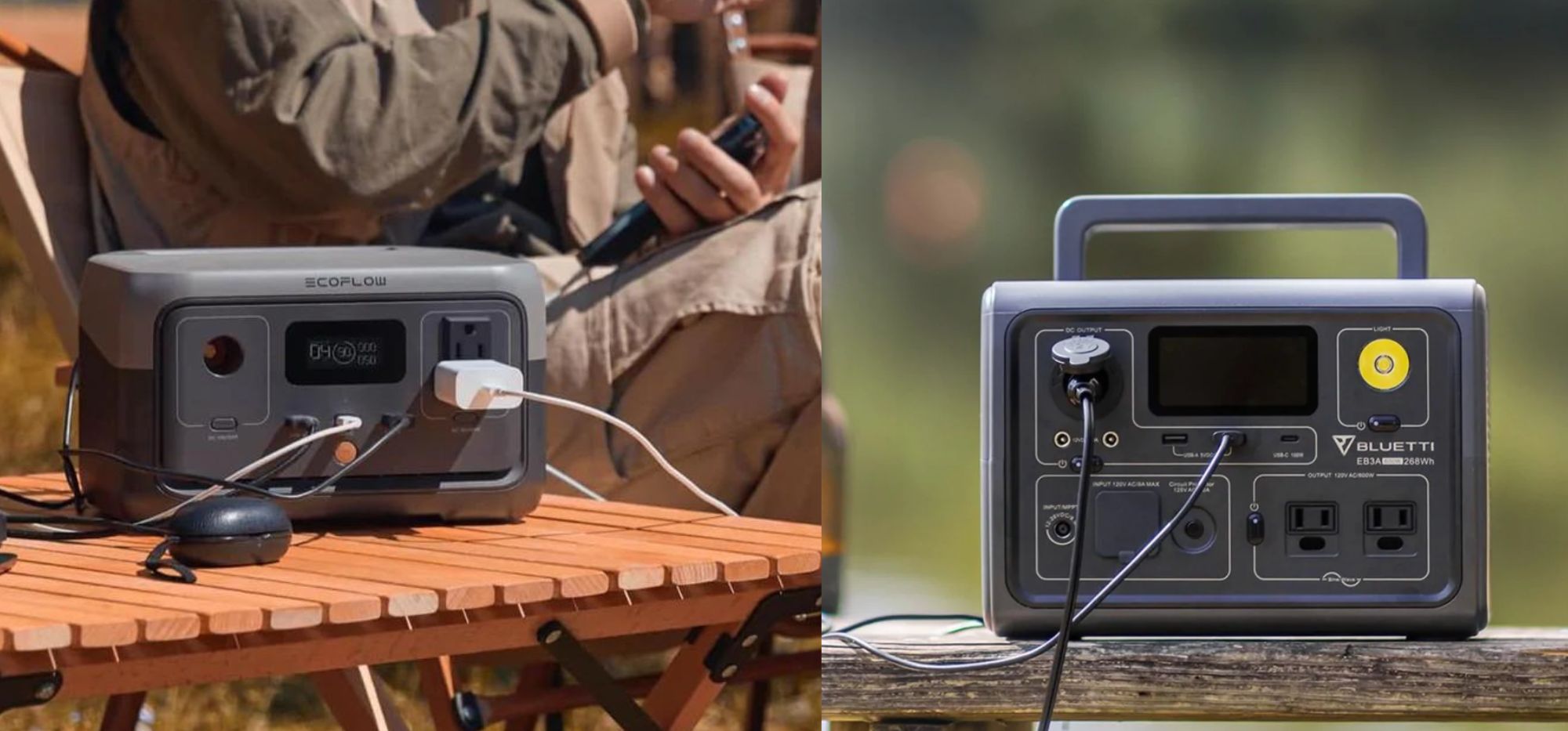
What’s in the box?
Bluetti EB3A:
- One Bluetti EB3A
- An AC charging cable
- A solar charging cable
- Quick start guide
- QC card
- Warranty card
EcoFlow River 2:
- One EcoFlow River 2
- One car charging cable
- One AC charging cable
- Quick start guide
- Warranty card
First impressions
Both power stations have well-built bodies and sleek designs that add character. I, however, liked River 2’s design a bit more due to its modern, minimalistic design.
And even though looks often matter, the features and performance matter more. So let’s have a closer look at the basic features:
| Bluetti EB3A | EcoFlow River 2 | |
| Weight | 10.14 lbs (4.6 kg) | 7.7 lbs (3.49 kg) |
| Size (LxWxH) | 10.04 x 7.09 x 7.20 in / 25.5 x 18.0 x 18.3 cm | 9.6 x 8.5 x 5.7in / 24.38 x 21.59 x 14.48cm |
| Number of ports | 11 ports | 9 ports |
| Cell Type | Lithium-ion Phosphate (LiFePO4) | Lithium-ion Phosphate (LiFePO4) |
| App Control | Yes | Yes |
| Information Display | Digital display (Has more info) | Digital Display |
| Warranty | 2 years full device warranty | 5 years full device warranty |
| Solar Bundles Available? | Yes (2 options, see here) | Yes (one option, view here) |
Portability
Should portability be the only factor in your decision, then the EcoFlow River 2 works for you. At 7.7lbs, it’s a tad lighter than the EB3A which weighs in at 10.14lbs. It also has a smaller frame. However, its size also means that it can’t accommodate much juice.
Ports
The Bluetti EB3A has a total of 11 ports, consisting of 8 output ports and 3 input ports. This means that you can charge up to 8 devices simultaneously.
On the other hand, The EcoFlow River 2 has a total of 9 ports, consisting of 6 output ports and 3 input ports. That gives you the capacity to charge up to 6 devices at a time.
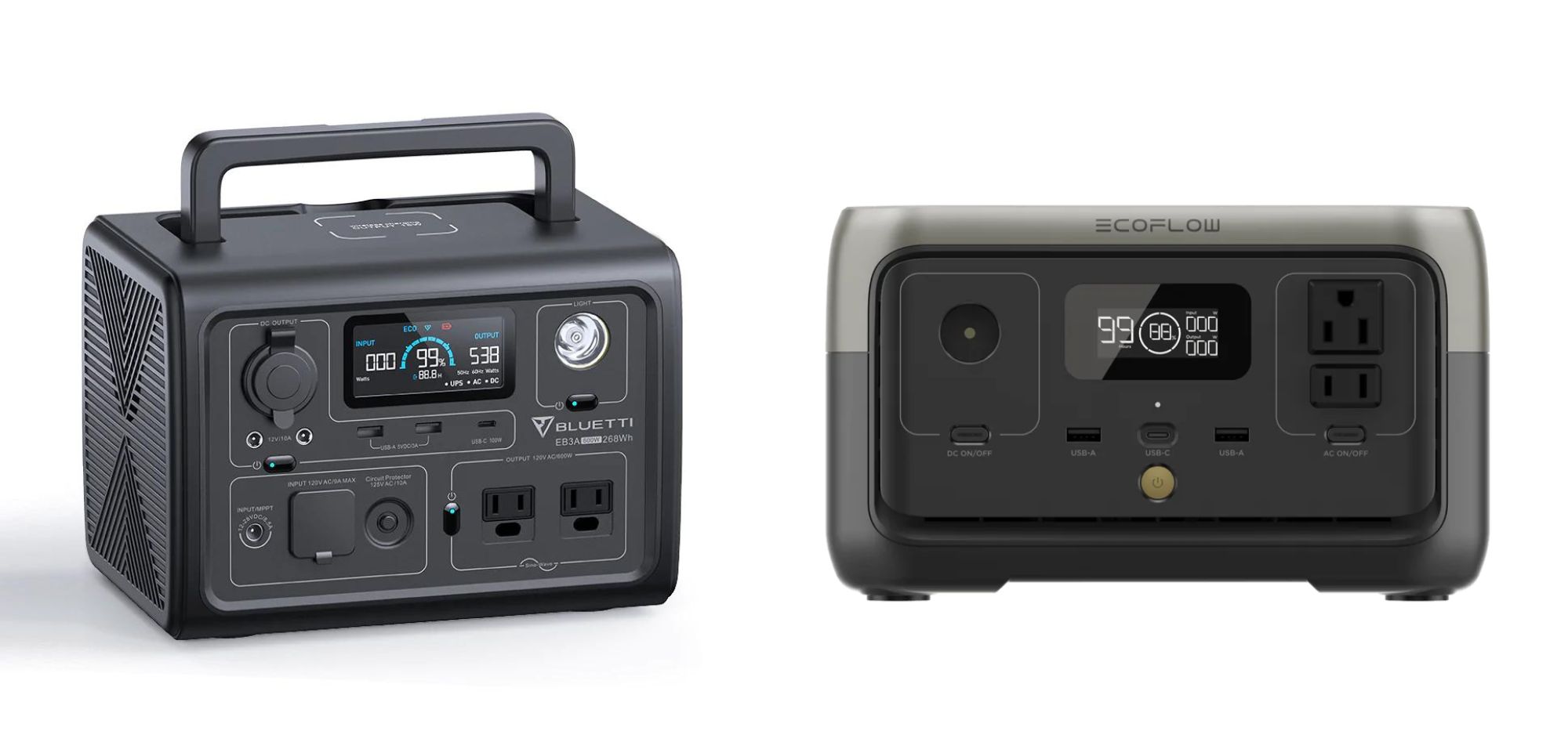
In that light, the EB3A is the better option if the number of ports is your main consideration.
| Bluetti EB3A | EcoFlow River 2 | |
| Output Ports | 8 ports | 6 ports |
| AC Outlets | 2 ports: 120V, 5A / 220-240V, 2.6A (600W max continuous, 1200W surge peak) | 2 ports: 120V (50/60Hz, 300W max continuous, 600W max surge) |
| USB-A Outlets | 2 ports: (5V, 3A each) | 2 ports: (5V, 2.4A / 12W max) |
| USB-C Outlet | 1 port: 100W max | 1 port: 60W max |
| Car Charger Outlet | 1 port: 12V, 10A | 1 port: 12.6V, 8A / 100W max |
| DC Outlets | 2 regular DC ports: 12V/10A, 5.5mm (Both regulated) | Same as car charger port |
| Wireless Charging Pads | 1 Pad | 0 Pads |
| Wireless Charging Pad | 1 pad: 15W max | No wireless charging (Quite a let-down considering the flat surface on the top) |
| Input Ports | 3 ports | 3 ports |
| AC Input | 1 port: 268W Max (Standard mode) / 350W Max (Turbo mode) | 1 port: 360W Max |
| Solar Charging Input | 12-28V, 8.5A (200W max) | 1 port: 11-30V, 8A (110W max) |
| Car Charging Input | 1 port: 12/24V | 1 port: 12/24V |
| User manual | EB3A manual | Riv 2 Manual |
Battery capacity and power
As mentioned before, the River 2 packs less juice than the EB3A. It boasts a capacity of 256Wh, while the Bluetti has 268.8Wh. In terms of battery power, the EB3A has double the power, at 600W compared to the River 2’s 300W.
| Bluetti EB3A | EcoFlow River 2 | |
| Battery Capacity | 268.8Wh | 256Wh |
| Max continuous Power | 600W | 300W |
| Surge Power | 1200W | 600W |
| Operating Temperature | -4°F – 104°F / -20°C – 40°C | 14°F – 113°F / -10°C – 45°C |
| Lifecycles | 2,500 cycles to 80% original capacity | 3,000 cycles to 80% original capacity |
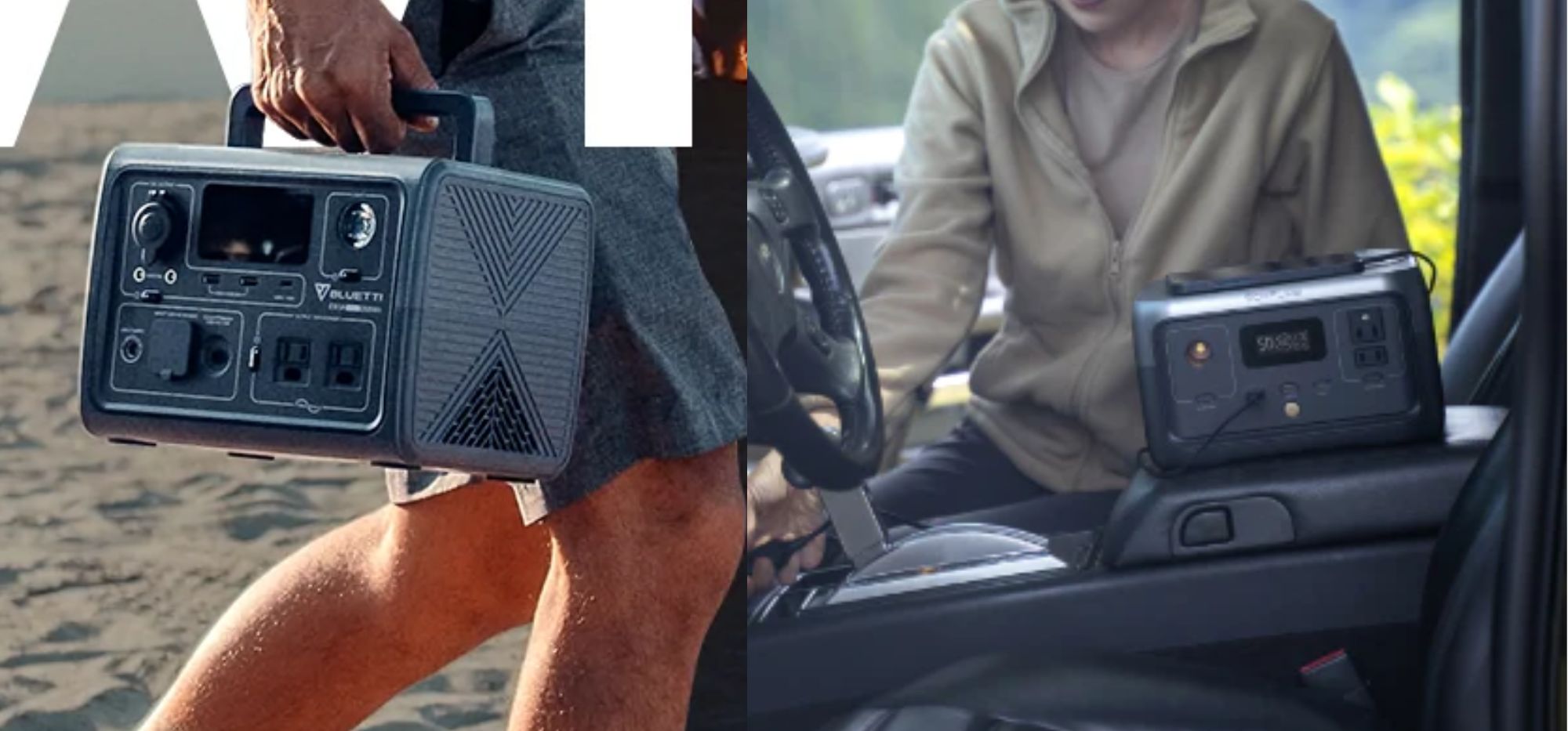
Recharge times
Both power stations have multiple charging options – AC, DC, and solar input. The River 2 charges faster when using the AC option, taking only 1 hour from 0-100%. When you do outdoors, the tables turn, and you can save up to 1 hour with the EB3A.
| Bluetti EB3A | EcoFlow River 2 | |
| AC Adapter | 1.3-1.8 hrs (350W) / 1.5-2.0 hrs (268W) | 1 hrs (360W) |
| Car adapter | 3.2-3.7 hrs (12V, 100W) / 1.9-2.4 hrs (24V, 200W) | 3.2-3.7 hrs (12V, 100W) |
| Solar Recharge | 1.8-2.0 hrs (200W) | 3.0 hrs (110W) |
Verdict
If portability is your main concern, then the EcoFlow River 2 should be at the top of your list. However, if you need a bit more power, then the EB3A’s extra capacity and output might work better for you.
Overall, both models are excellent products and offer great value for money. Just make sure to weigh your needs carefully before choosing.
2. Low range (around $500) – Ecoflow River Pro vs. Bluetti EB55
The River Pro and EB55 offer great value for the money, while still packing enough power to meet light energy needs.
| PREVIEW | PRODUCT | |
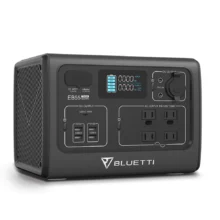
|
Bluetti EB55 | See on Bluetti |

|
Ecoflow River Pro | See on Ecoflow |
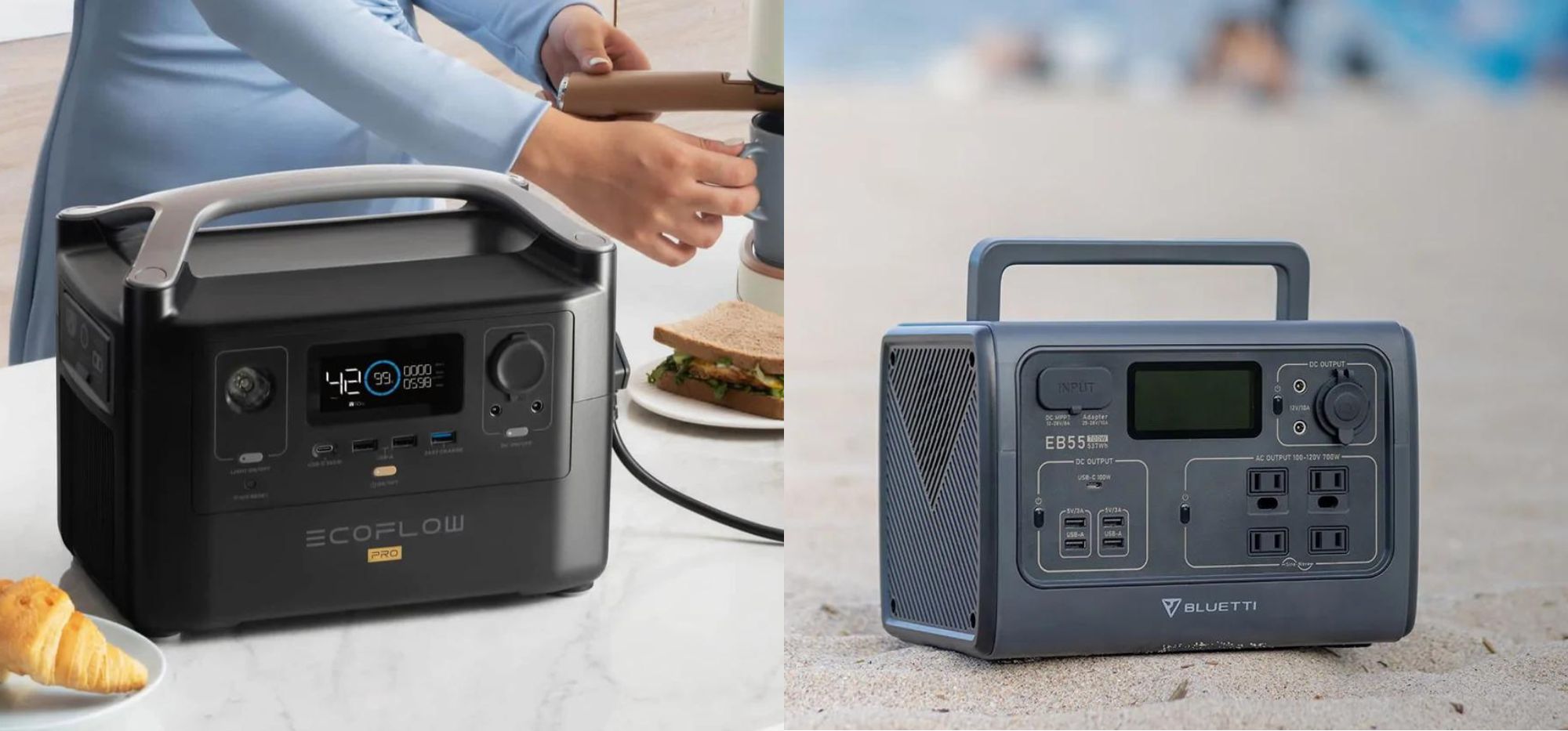
What’s in the box?
Bluetti EB55:
- One Bluetti EB55
- An AC charging cable (2 parts: adapter plus charging cable)
- One solar charging cable
- One Car charging cable
- One warranty card
- Quick start guide
EcoFlow River Pro:
- One EcoFlow River Pro
- One car charging cable
- One AC charging cable
- One DC cable
- Quick start guide
- Warranty card
First impressions
Both units look sleek and modern, with a sturdy build that makes them perfect for outdoor use. This time, I liked the design of the Bluetti more due to the placement of the ports.
For the Bluetti, all the ports are located at the front of the device, but with the River Pro, they are divided between the front and sides. For most users, however, this should not be a problem.
Looking closer at the features, here’s what the units have to offer:
| Bluetti EB55 | Ecoflow River Pro | |
| Weight | 16.5 lbs (7.5 kg) | 16.8 lbs (7.62 kg) |
| Size (LxWxH) | 10.94 x 7.87 x 7.79 in / 27.78 x 19.98 x 19.78cm | 11.4 x 7.1 x 9.3in / 28.9 x 18.0 x 23.5cm |
| Number of ports | 15 ports | 13 ports |
| Battery Type | Lithium-ion Phosphate (Superior to Lithium-Ion) | Lithium-ion |
| Information Display | Digital display | Digital display |
| App Control | No | Yes |
| Warranty | 2 years warranty | 2 years warranty |
| Solar Bundles Available? | Yes (2 options) | Yes (one option, view here) |
| User manual | EB55 manual | River Pro Manual |
Portability
As far as weight is concerned, these two battery stations are almost the same. The River Pro weighs slightly more at 16.8 lbs, while the EB55 comes in at 16.5 lbs.
When it comes to portability, the EB55 has a slight advantage. It’s a tad slimmer, but the difference is not something you’d usually notice.
Ports
The EB55 has a total of 15 ports, consisting of 12 output ports and 3 input ports. As such, you can charge up to 12 devices at a time with this power station.
With a total of 13 ports, on the other hand, the River Pro offers slightly less versatility. It has 10 output ports and 3 input ports which allow you to charge up to 10 devices at once.
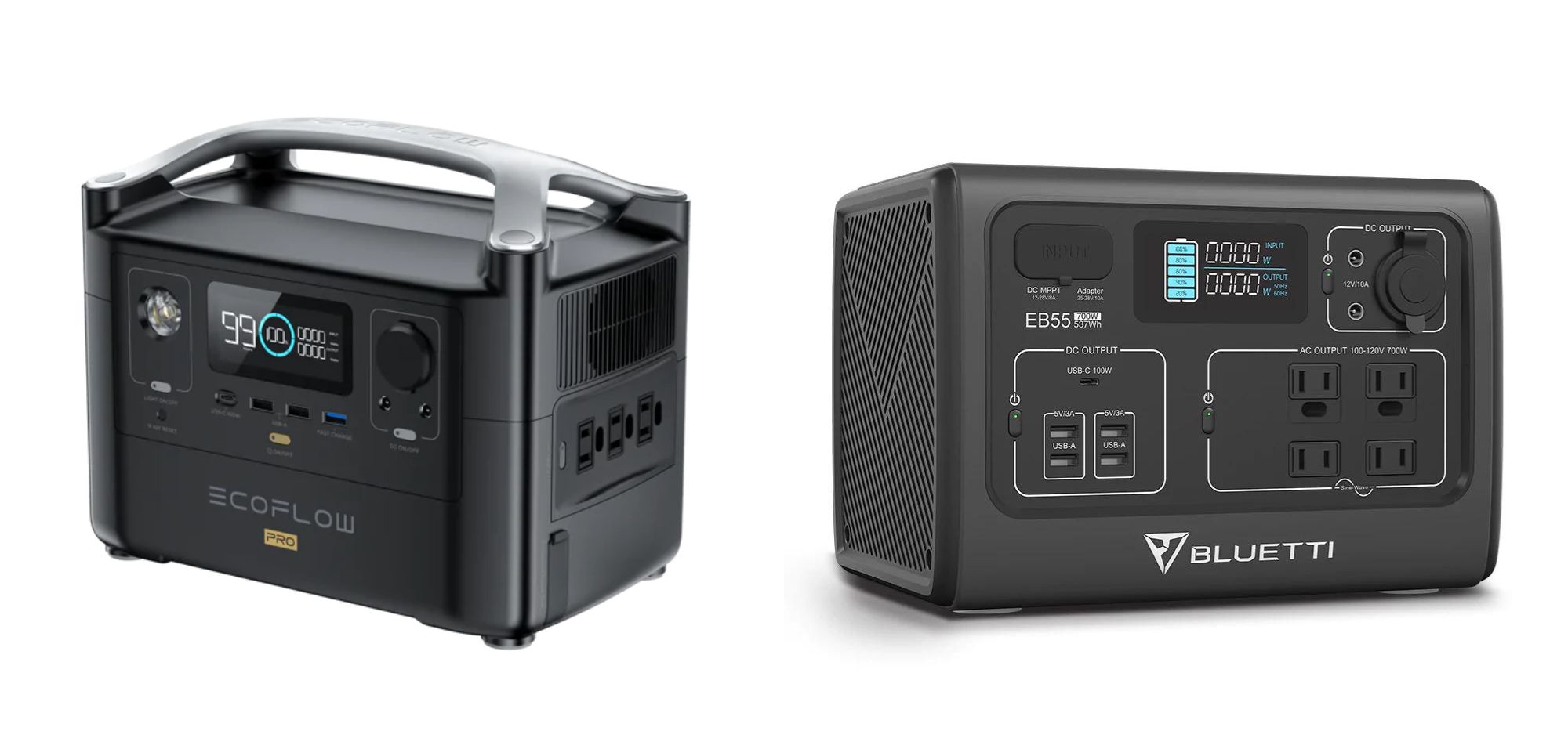
This makes the EB55 the better choice if you need to charge multiple devices simultaneously.
| Bluetti EB55 | Ecoflow River Pro | |
| Output Ports | 12 ports | 10 ports |
| AC Outlet | 4 Ports: 100-120V, 20A (700W total max continuous, 1400W surge peak) | 3 Ports: 120V (50/60Hz, 600W total max continuous, 1200W max surge) |
| USB-A Outlets | 4 Ports: (5V, 3A each) | 2 Ports: (5V, 2.4 A / 12W),
1 Fast Charge Port: (5/9/12V, 2.4A / 28W) |
| USB-C Outlets | 1 Port: (100W Max) | 1 Port: (100W Max) |
| Car Charger Outlet | 1 Port: 12V, 10A | 1 Port: 13.6V, 10A |
| DC Outlet | 2 Ports: 12V, 10A) | 2 Ports: 13.6V, 3A |
| Wireless Charging Pads | 1 Pad | 0 Pads |
| Wireless Charging Pad | 1 pad: 15W max | No wireless charging option |
| Input Ports | 3 ports | 3 ports |
| Car Input | 1 port: 12-24V, 8A max | 1 port: 12/24V, 8A max |
| Solar Input | 1 port: 12-28V, 8A (200W max) | 1 port: 10-25V, 12A (200W) |
| AC Input | 1 port: 200W (AC-DC charger, supplied) / 400W (Dual AC charging, requires extra charger) | 1 port: 100-120V, 660W |
Battery capacity, and power
Even though the difference in size and weight is quite negligible, there is a notable difference when it comes to the capacity. The River Pro has a higher capacity of 720Wh, while the EB55 works with 537Wh.
In terms of power, the Bluetti EB55 surprisingly has more to offer, with a continuous output of 700W compared to the River Pro’s 600W.
| Bluetti EB55 | Ecoflow River Pro | |
| Battery Capacity | 537Wh | 720Wh |
| Continuous Power | 700W | 600W |
| Surge Power | 1400W | 1200W |
| Expandable Battery | No | Yes (720Wh to 1440Wh) |
| Operating Temperature | -4°F – 104°F / -20°C – 40°C | -4°F – 113°F / -20°C – 45°C |
| Lifecycle | 2,500 cycles to 80% original capacity | 800+ cycles to 80% of original capacity |
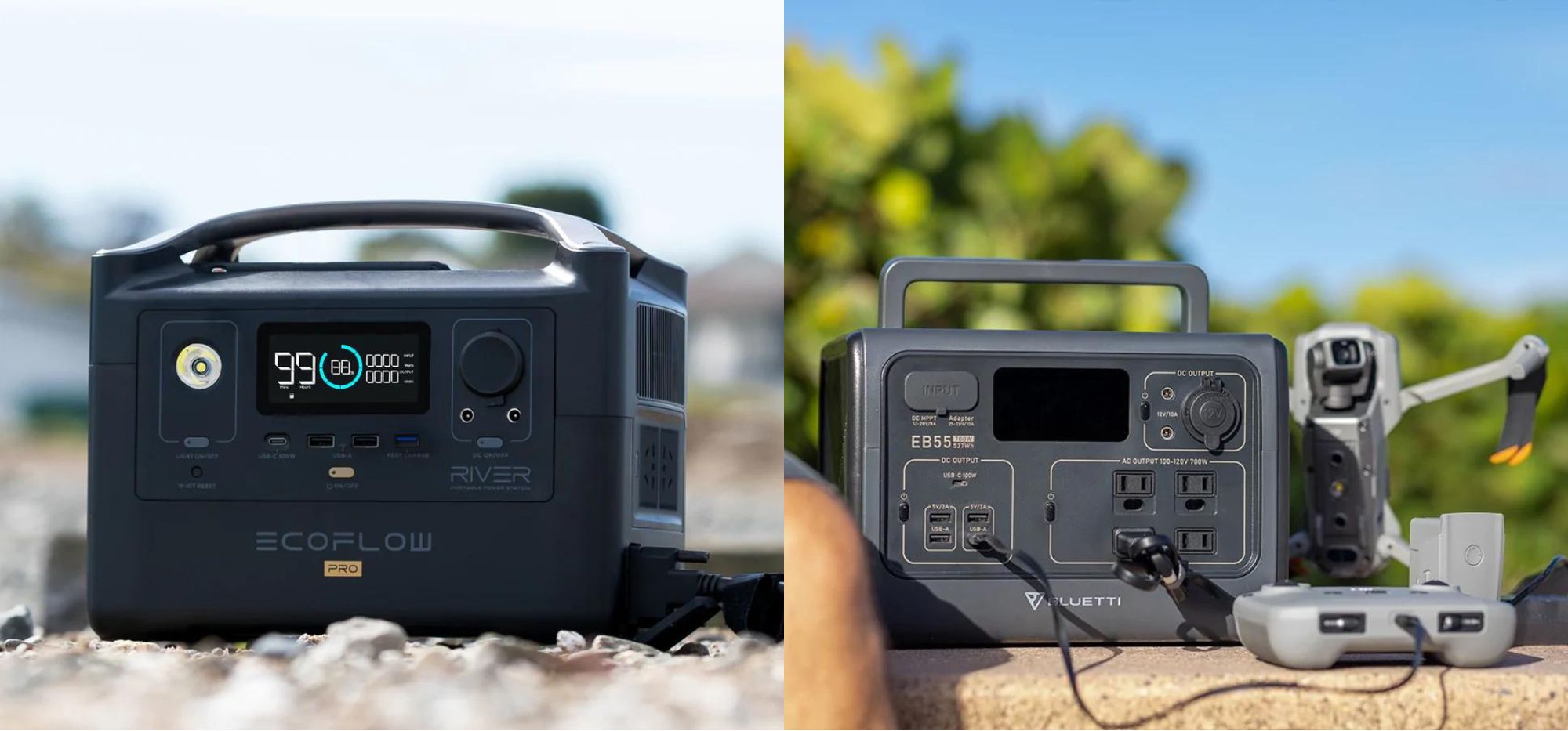
Recharge times
The EB55 takes almost an hour longer to charge fully when using the AC outlet, taking 3.0 hours in total compared to the River Pro’s 1.6 hours. On the other hand, it takes slightly lesser time to recharge using a car or solar charger.
| Bluetti EB55 | Ecoflow River Pro | |
| AC Adapter | 3.0 hrs (200W) | 1.6 hrs |
| Car adapter | 6.1 hrs (12V, 100W) / 3.4 hrs (24V, 200W) | 6.55 hrs (12V) |
| Solar Recharge | 3.0 hrs (200W) | 4-9 hrs (2 x 110W solar panels) / 6-12 hrs (1 x 160W Solar Panel) |
Verdict
The River Pro and EB55 are both great budget-friendly power stations. The River Pro has more capacity, while the EB55 offers more power. It all depends on which of these features is most important for your needs.
I think that the most important factor here is that the River Pro is Lithium-ion based, while the EB55 uses Lithium-ion Phosphate battery cells. This could make a real difference in terms of durability and long-term performance, so bear it in mind when making your decision.
3. Mid range (around $1000) – Ecoflow Delta 2 vs. Bluetti EB150
Warning: Bluetti EB150 is a very old model and has been discontinued on their official site. It is available on Amazon though. I highly suggest you avoid this model if you can
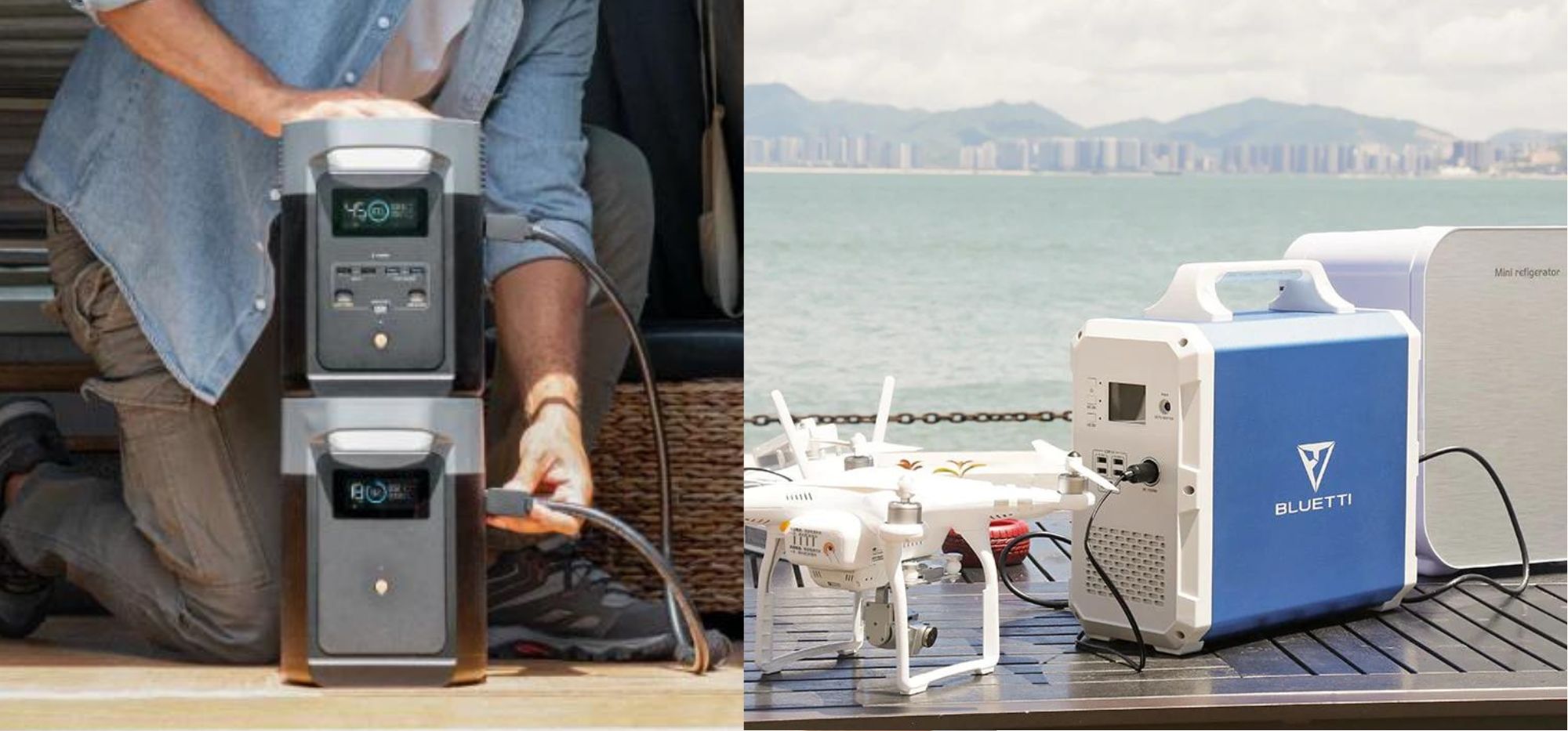
EcoFlow Delta 2 and Bluetti EB150 meet the sweet spot of 1000W. Hence this is one of the most sought-after categories in power stations.
| PREVIEW | PRODUCT | |
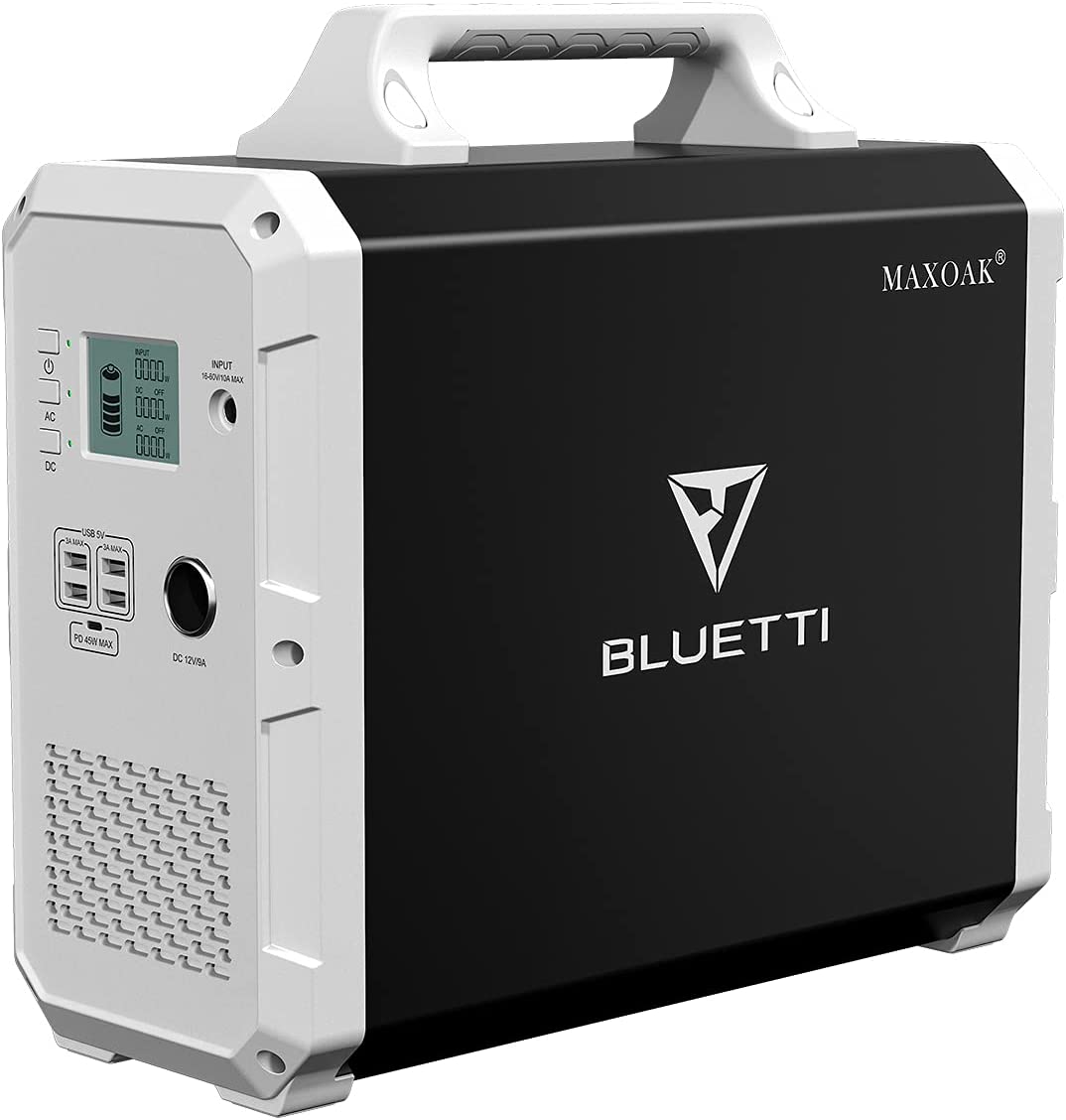
|
Bluetti EB150 | Unavailable on Bluetti |
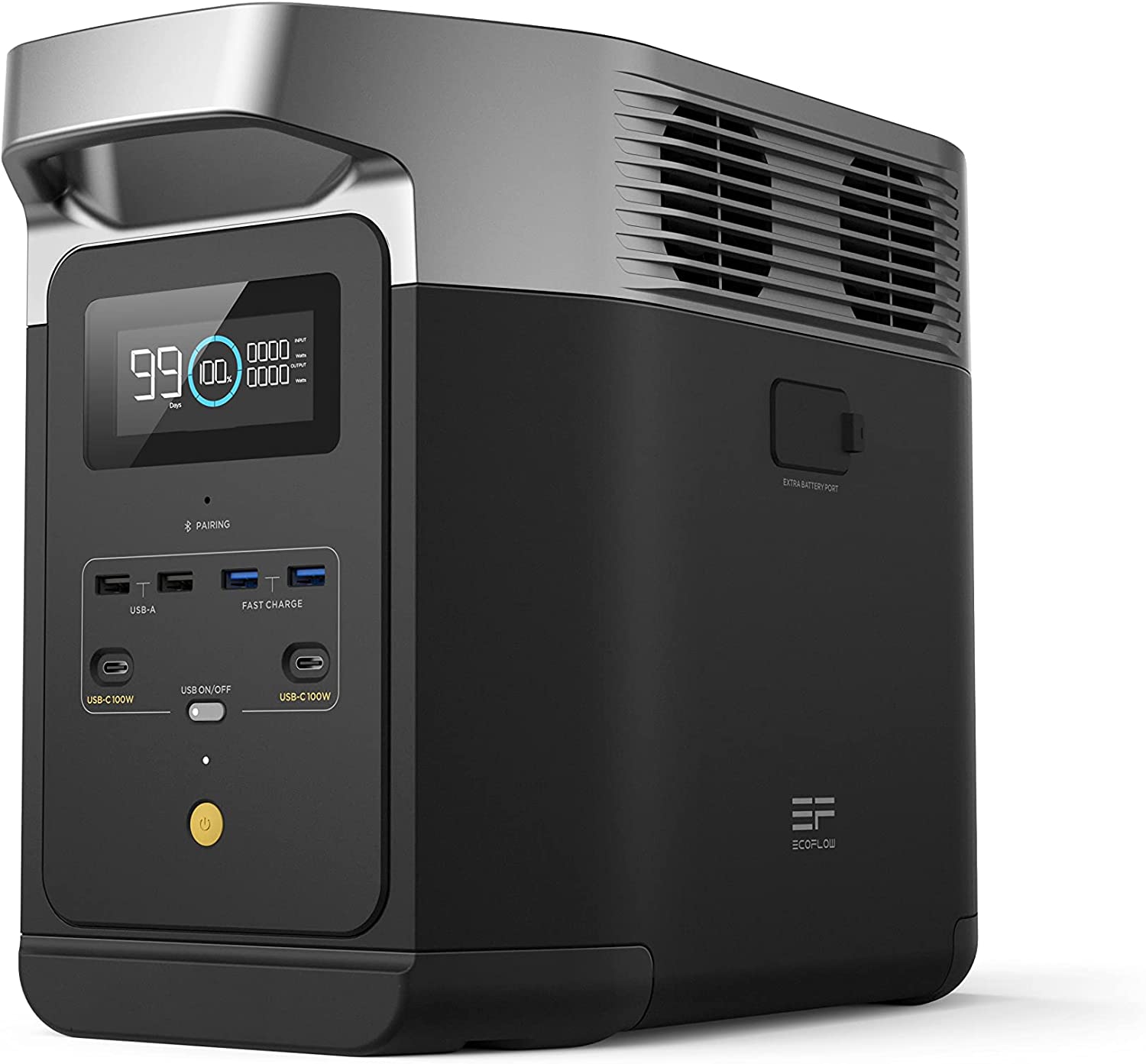
|
Ecoflow Delta 2 | See on Ecoflow |
What’s in the Box
Both of these battery stations come in a huge box with safe thermocol/polystyrene wraps. It is super heavy, so carrying the box is more difficult than carrying just the battery unit.
EcoFlow Delta 2
- PV Solar Charge Cable (DC5521 to DC5525)
- AC Wall Charger
- Car Charge cable
- DELTA 2 Power Station
- User Manual
- EF DELTA Bag
Bluetti EB150
- PV Solar Charge Cable (7909 to MC4)
- AC Wall Charger (including AC input charging cable)
- EB150 Solar Power Generator
- User Manual
- Warranty Card
- Certificate of Qualification
First Impression
EC Delta2 is more aesthetic than EB150. The nice color combination makes it awesome looking. Also, the body is designed so well to make it look like a futuristic gadget. In terms of look, EcoFlow Delta is better, hands down.
Looking closer at the features, here’s what the units have to offer:
| Bluetti EB150 | Ecoflow Delta 2 | |
| Weight | 37.9 lbs / 17.2 KG | 27 lbs / 12 kg |
| Size (LxWxH) | 14.6 × 6.5 × 14.4 inch / 371.5 × 165.4 × 364.7mm |
15.7 x 8.3 x 11 in (400 x 211 x 281 mm) |
| Number of ports | 10 ports | 16 ports |
| Battery Type | Lithium-ion | LFP |
| Information Display | Digital display | Digital display |
| App Control | No | Yes |
| Warranty | 2 years warranty | 5 years warranty |
| User manual | EB150 | Delta 2 |
Portability
As far as weight is concerned, one is heavier than the other. The Delta 2 weighs less at 27 lbs, while the EB150 comes in at 37.9 lbs.
When it comes to portability, the Delta 2 has an advantage. But, Bluetti is slimmer and can fit in easily in small places.
Ports

The number of ports and the power ratings is compared in the following table.
| EcoFlow Delta 2 | Bluetti EB150 | |
| Output Ports | 13 | 8 |
| AC Power Outlets (110V) | 6 Ports 1800W each | 2 Ports 1000W each |
| USB A Ports | 2 ports, 5V, 2.4A, 12W Max | 4 Ports 3A Max |
| USB C Ports | 2 Ports 100W Max | 1 Port 45W |
| DC Car Port | 1 port, 12.6V, 10A, 126W Max | 12V 9A |
| DC Output Port | 2 ports, 12.6V, 3A, 38W Max | – |
| Input Ports | 3 | 2 |
| Solar/DC Input Port | 65V 10A | 16 – 60V / 10A |
| AC Charging Port | 1200W (100-120V~ 50Hz/60Hz) | 200 W 220V 50Hz |
| Car Charging Port | 12V/24V, 8A | – |
As we can see, Bluetti EB150 misses out on a lot of ports both input and output ports.
Battery capacity, and power
In terms of capacity, EcoFlow Delta 2 outperforms Bluetti EB150 both in Power and Surge capacity. But in the battery capacity, Bluetti is way above Ecoflow. If you ask me, both power and battery capacity are good to consider. The more power you have, the more devices can be powered simultaneously. For example, you can drive a TV (150W), an Oven (900W), and a refrigerator (600W) simultaneously using a 1800W power station. With a 1000W station, you can only power an Oven or TV + Fridge, not all of them together.
On the other hand, a high battery capacity helps you run devices for a longer period of time. For example, you can run your oven for 1.8 hours with Bluetti while it’s only 1.2 hours with Delta 2.
There is a clear trade-off, if you need one, you may have to miss the other.
Also, EcoFlow Delta 2 has higher LifeCycle due to the use of LFP battery.
| Bluetti EB150 | Ecoflow Delta 2 | |
| Battery Capacity | 1500Wh | 1024Wh |
| Continuous Power | 1000W | 1800W |
| Surge Power | 1000W | 2700W |
| Expandable Battery | No | Yes (Upto 3kWh) |
| Lifecycle | 2,500 cycles to 80% original capacity | 3000+ cycles to 80% capacity (LFP Battery) |
Recharge times
Both the power station support more than one way to charge them. The following table highlights the difference.
| EcoFlow Delta 2 | Bluetti EB150 | |
| AC Wall Outlet | ~1.6 Hours for a full charge | ~10 Hours for a full charge |
| Solar Panel | Supports 500W Panel | Supports 400W Panel |
| Car | Yes (~13.5 Hours) | No |
| Solar Bundles | Yes (2 options, view here) | No |
The charge time of EcoFlow Delta 2 is significantly lesser than that of Bluetti EB150. Also, having the option to charge via your car is a good thing to have. EcoFlow Delta 2 has the option for you while Bluetti EB150 missed it.
Verdict
The Delta 2 and EB150 are both great 1000W category power stations. Delta 2 is newly released and hence packs all the latest technology. EB150 is an older model and hence lacks some of the significant features. The only reason to pick Bluetti EB150 would be for that big battery capacity. In all other aspects, Delta 2 is the clear winner.
4. High range (around $2000) – Ecoflow Delta Max (2000) vs. Bluetti AC200Max
These two power stations from EcoFlow and Bluetti are some of the most powerful units in their respective lineups. Both offer plenty of power for most of your energy needs and are great investments for those who need something a bit more powerful than the others on this list.
| PREVIEW | PRODUCT | |
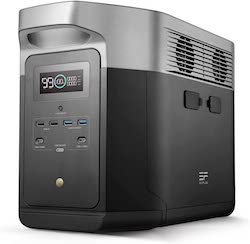
|
EF Delta Max | See on Ecoflow |
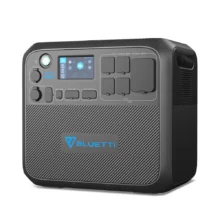
|
Bluetti AC200Max | See on Bluetti |
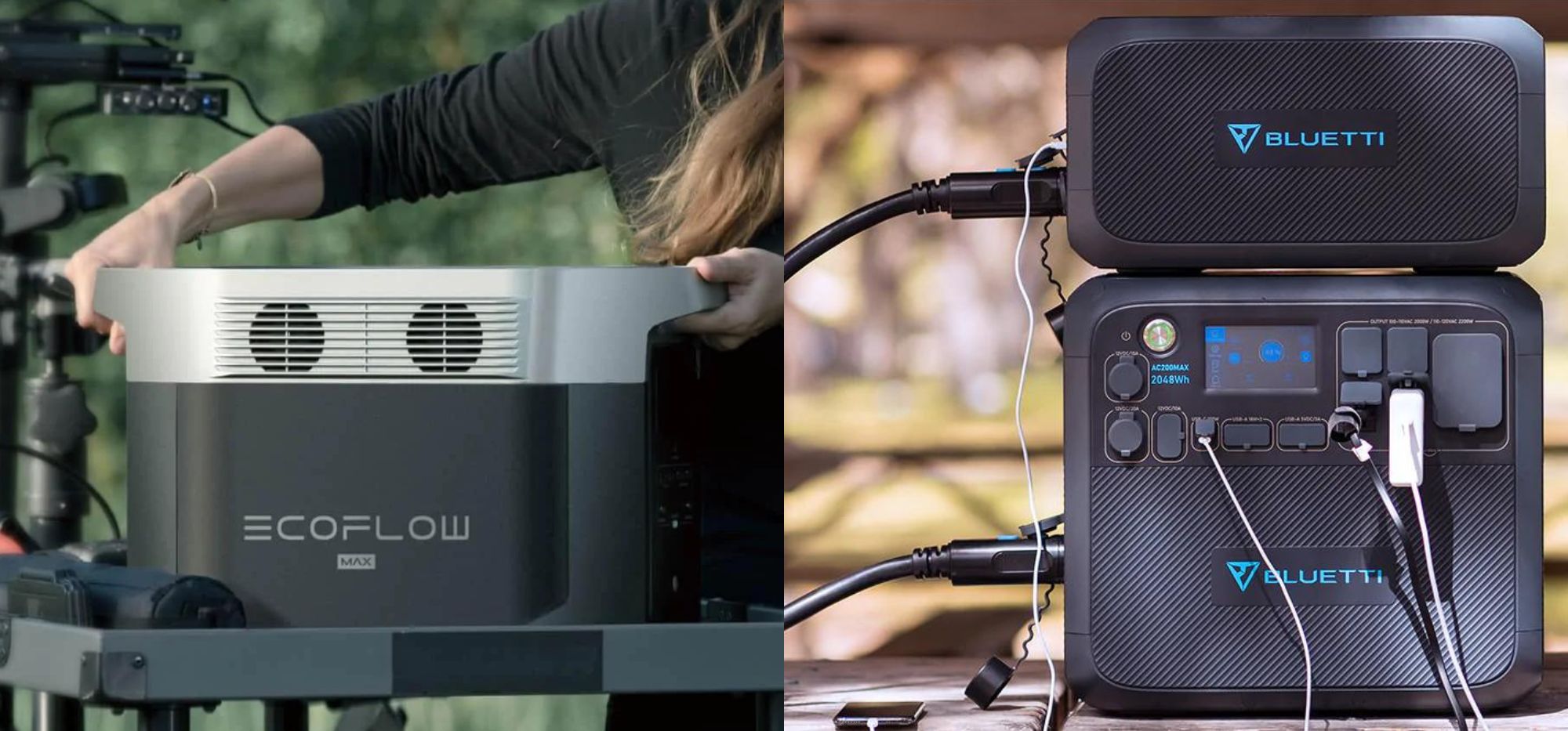
What’s in the box?
Bluetti AC200Max:
- One Bluetti AC200Max power station
- One solar charging cable
- An AC charging cable (2 parts: adapter and charging cable)
- One car charging cable
- One multi-functional aviation cable
- Warranty card
- QC certificate
- User manual
EcoFlow Delta Max (2000)
- One Delta Max (2000)
- One AC charging cable
- A car charging cable
- One solar charging cable
- A DC5521 to DC5525 Cable
- Warranty card
- User manual
First impressions
The Delta Max (2000) and AC200Max both look a bit different from their lower-priced siblings. Both feature a contemporary design, but with that ” I mean business” look.
The only difference that is immediately noticeable is that the Bluetti AC200Max has a dual wireless charging pad system at the top. This gives it an even more premium, expensive feel.
But I like comparing all the details that matter, so here is a features comparison table, to that end.
| Bluetti AC200MAX | EcoFlow Delta Max (2000) | |
| Weight | 61.9 lbs (28.1kg) | 48.5 lbs (22kg) |
| Size (LxWxH) | 16.5 x 11 x 15.2 in / 42 x 28 x 38.65 cm | 19.6 x 9.5 x 12 in / 49.7 × 24.2 × 30.5cm |
| Number of ports | 17 ports | 14 ports |
| Battery Type | Lithium-ion Phosphate (Superior to Lithium-Ion) | Lithium-ion (NCM) |
| App Control | Yes | Yes |
| Information Display | Touchscreen display (More detailed) | Digital display |
| Warranty | 4 years full device warranty | 2-year warranty |
| Solar Bundles Available? | Yes (2 options, view here) | Yes — 3 options: option 1 (160W) option 2 (220W), option 3 (400W) |
| Expandable Battery Bundles | Yes | Yes |
Portability
The Delta Max (2000) and AC200Max are among the heaviest units on this list, weighing in at 48.5 lbs and 61.9 lbs respectively. However, despite the weight difference, they are both easy to move around due to their handle placement and overall design.
Ports
The Bluetti AC200MAX has a total of 17 ports, consisting of 14 output ports and 3 input ports. Therefore, you can enjoy the convenience of charging up to 14 devices simultaneously with this power station.
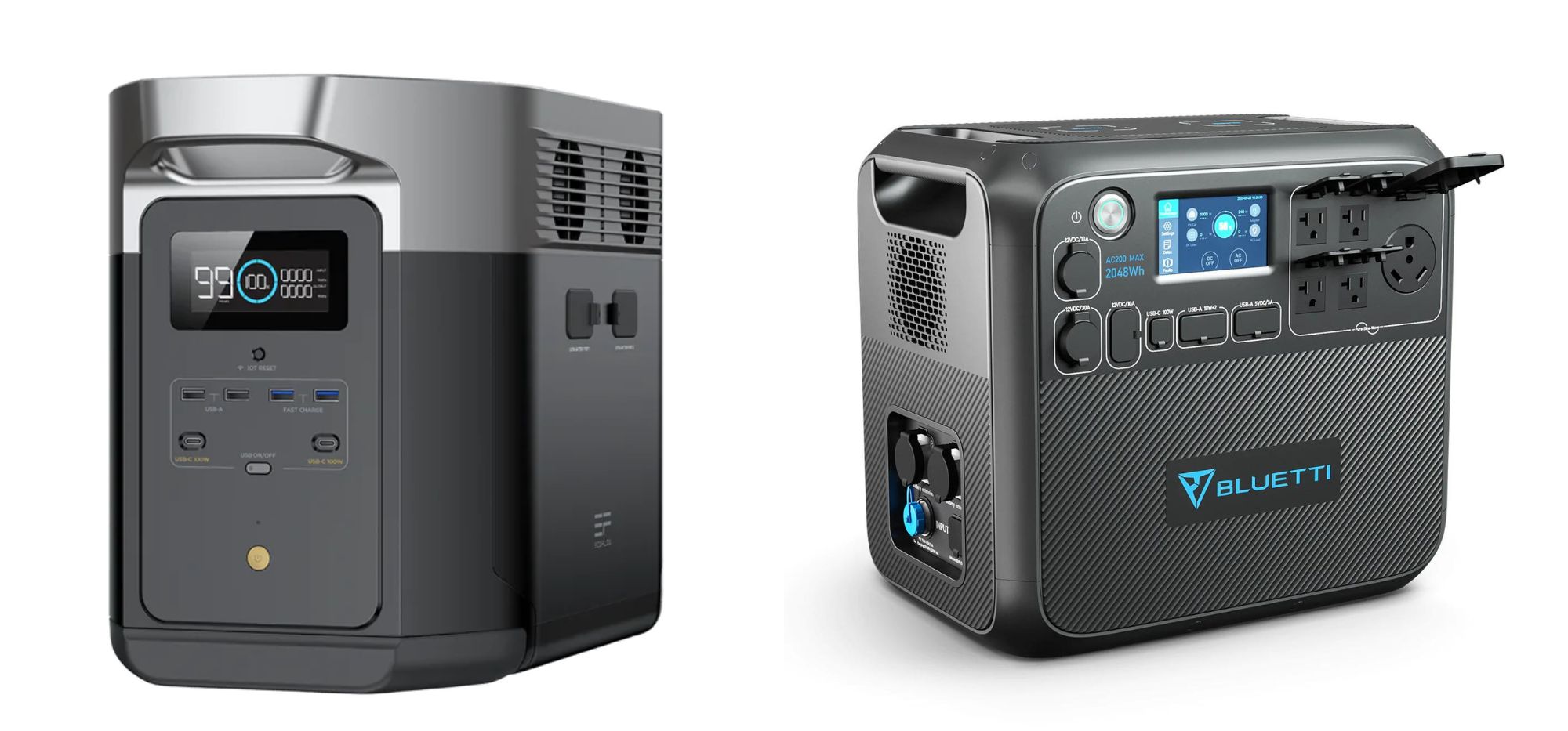
On the other hand, the Delta Max (2000) is slightly modest, with a total of 14 ports: 11 output ports, and 3 input ports.
| Bluetti AC200MAX | EcoFlow Delta Max (2000) | |
| Output Ports | 14 ports | 11 ports |
| AC Power Ports | 4 ports: 120V/20A
1 port: 120V/30A (2200W total max continuous, 4800W surge peak) |
4 ports: 230V, 50Hz/60Hz
(2400W total max continuous, 4600W surge peak) |
| USB-A Ports | 2 ports: 5V, 3A each
2 ports: 18W each) |
2 ports: 5V, 2.4A (12W max) |
| USB-C Ports | 1 port: 100W Max | 2 ports: 100W max |
| Car Power output | 1 port: 12V, 10A | 1 port: 12.6V, 10A |
| DC Output | 2 ports: 12V, 10A / 5.5mm
1 port: 12V, 30A / RV outlet |
2 ports: 12.6V, 3A |
| Wireless Charging Pads | 2 Pads | 0 Pads |
| Wireless charging | 2 pads: 15W max (for each) | No wireless charging option |
| Input Ports | 3 ports | 3 ports |
| AC Charging Input | 1 port: 100-240V, 500W max | 1 port: 220-240V, 2000W max |
| Solar Charging Input | 1 port: 10-145VDC, 15A (900W max) | 1 port: 11-100VDC, 10A (800W max) |
| Car Charging Input | 1 port: 12/24V, 8A max | 1 port: 12/24V, 8A max |
| User Manual | AC300Max Manual | Delta Max Manual |
Battery capacity and power
The AC200Max has a larger capacity of 2048Wh while the Delta Max (2000) has a slightly lower capacity of 2016Wh.
In terms of power, the Delta Max (2000) is more powerful with a continuous output of 2400W compared to the AC200Max’s 2200W.
| Bluetti AC200MAX | EcoFlow Delta Max (2000) | |
| Battery Capacity | 2048Wh | 2016Wh |
| Max Continuous Power | 2200W | 2400W |
| Surge Power | 4800W | 4600W |
| Expandable Battery | Yes: (2kWh, 6kWh, 8kWh) | Yes: Up to 6kWh |
| Operating Temperature | -4°F – 104°F / -20°C – 40°C | -4°F – 113°F / -20°C – 45°C |
| Lifecycle | 3,500 cycles to 80% original capacity | 800 cycles to 80%+ capacity |
Recharge times
The most notable difference between these two models is the AC recharge time. Thanks to the Delta Max’s 2000W max input, it can clock in a full charge in just about 1.6 hours. The AC200Max takes longer, at 5.5-6 hrs when using a 400W input.
| Bluetti AC200MAX | EcoFlow Delta Max (2000) | |
| AC Input | 5.5-6 hrs (400W) | 1.6 hrs (2000W) |
| Car Input | 20 hrs (12V, 100W) | 21 hrs (12V, 100W) |
| Solar Input | 3.0-3.5 hrs (900W) | 3.2-6.3 hrs (800W) |
Which one is the better pick?
Both the Delta Max (2000) and AC200Max provide a great balance of portability, capacity, power, and recharge times. The Delta Max (2000) is a great option for those who prioritize quick AC recharge times, but then again, you’ve got to consider that it’s Li-ion based.
In general, LiFePO4 batteries are more reliable and durable, so the Bluetti AC200Max is a better choice if that’s your main concern.
5. Top Range (around $3000) – Ecoflow Delta Pro vs. Bluetti AC300 + B300
This category is the go-to option for those who need the absolute best in terms of capacity, power, and portability. For this one, I chose to weigh up the EcoFlow Delta Pro and the Bluetti AC300.
| PREVIEW | PRODUCT | |
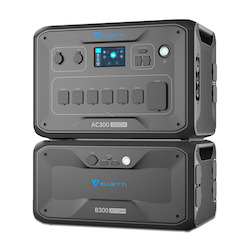
|
Bluetti AC300 | See on Bluetti
Amazon – Not Yet Available |
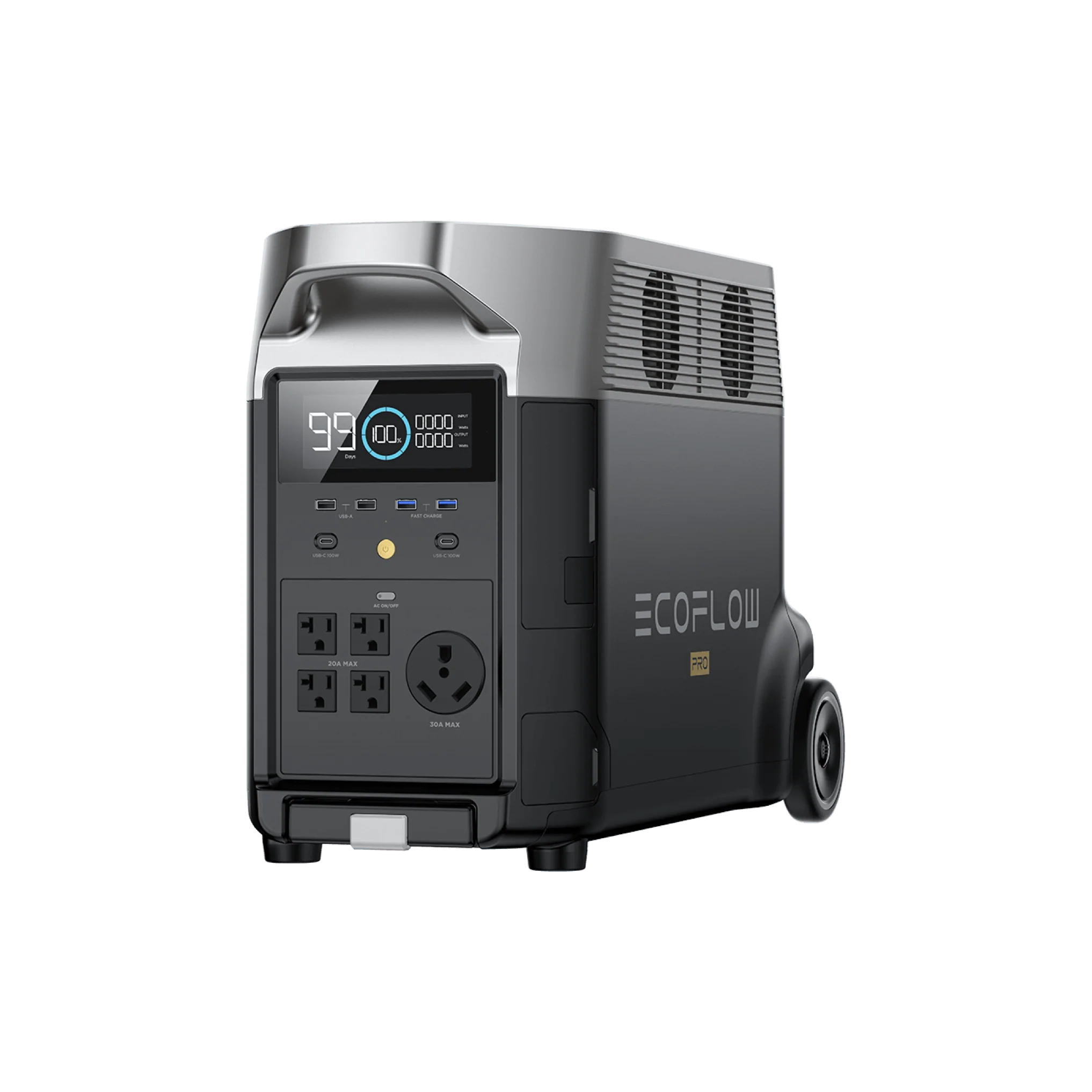 |
EcoFlow Delta Pro | See on Ecoflow |
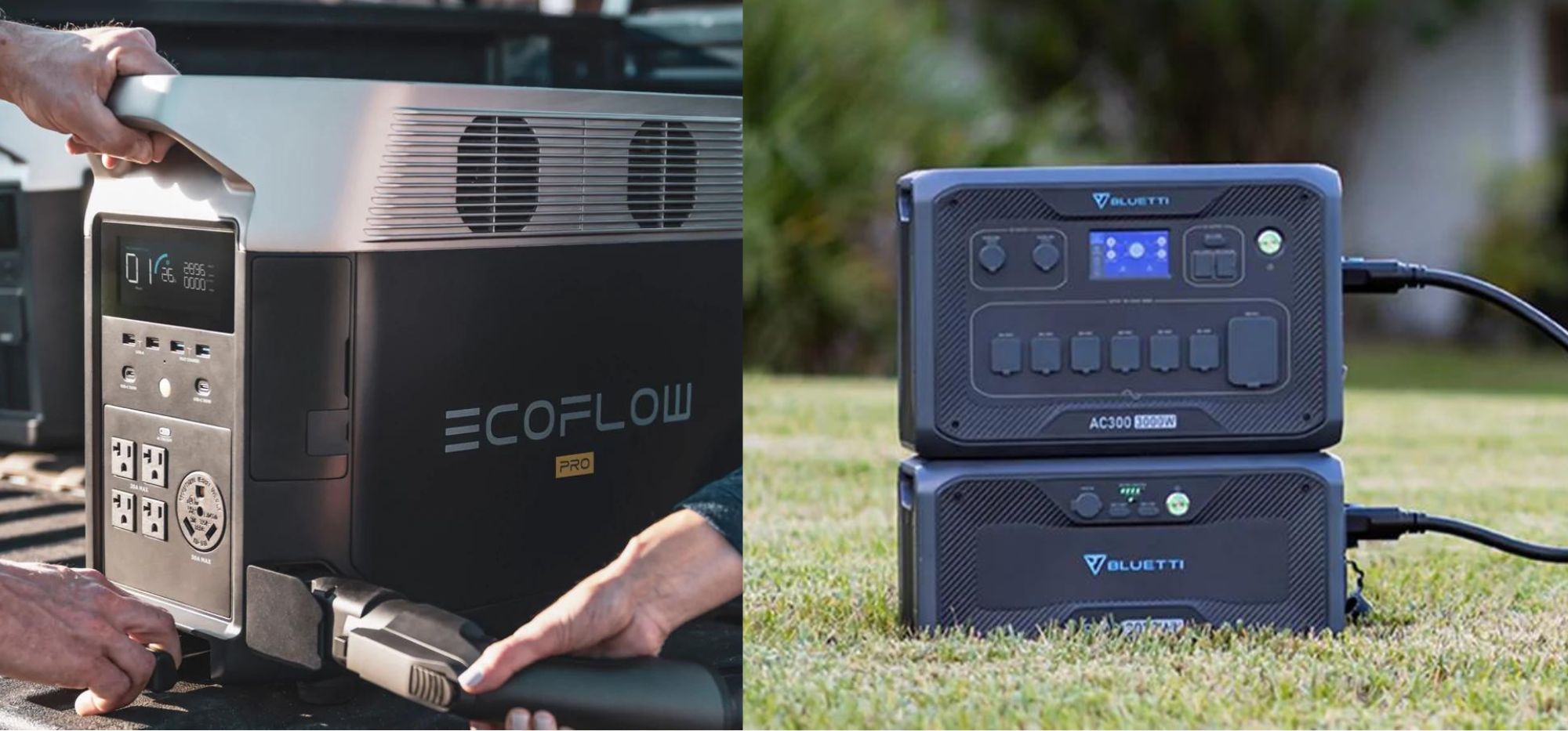
What’s in the box?
Bluetti AC300
- One Bluetti AC300 inverter module
- One Bluetti B300 expansion battery
- A 15A AC charging cable
- One car charging cable
- One multifunctional DC charging cable
- QC card
- Warranty card
- User manual
EcoFlow Delta Pro
- One Delta Pro
- A car charging cable
- One AC charging cable
- DC5521 to DC5525 Cable
- Solar charging cable 3.5ml
- Delta Pro to Smart Generator adapter
- Handle cover
- Warranty card
- User manual
First impression
Both battery stations would look great in your home, or even on the road. I, however, like the Delta Pro more as it comes as a single unit, without compromising the portability since it has wheels.
On the other hand, the AC300 + B300 comes as two separate units: an inverter module, and an expansion battery. The AC300 on its own is not a battery station, so keep that in mind.
That said, here is a comparison table with the main features.
| Bluetti AC300 + B300 | EcoFlow Delta Pro | |
| Weight | 127.22 lbs (57.71 kg) | 99 lbs (45 kg) |
| Number of ports | 23 ports combined:
17 ports on the AC300 6 ports on the B300 |
18 ports |
| Battery Type | Lithium-ion phosphate (LiFePO4) | Lithium-ion phosphate (LiFePO4) |
| Warranty | 4 years | 2 years + 3 years extension registration |
| Solar Bundles Available? | Yes (2 options, see here) | Yes 2 options (Rigid panel option, portable panel option) |
| Expandable Battery Bundles | Yes | Yes |
| User Manual | AC300 | Delta Pro |
Portability
Both the Delta Pro and AC300 are quite portable, but the Delta Pro is the clear winner here. Not only does it have wheels that make it effortless to move around, but it also weighs in at 99 lbs.
The Bluetti AC300, on the other hand, has a combined weight of 127.22 lbs.
Ports
Of course, you want to be able to charge all your devices, so let’s compare the ports. The Delta Pro features 18 ports in total: 15 output ports for charging as many as 15 devices, and 3 input ports.
The AC300 + B300 unit is quite complicated. It has a total of 23 ports when combined. The AC300 makes up for 17 of the ports, with 14 output ports and 3 input ports. On the other hand, the B300 has 6 ports made up of 3 output ports and 3 input ports.
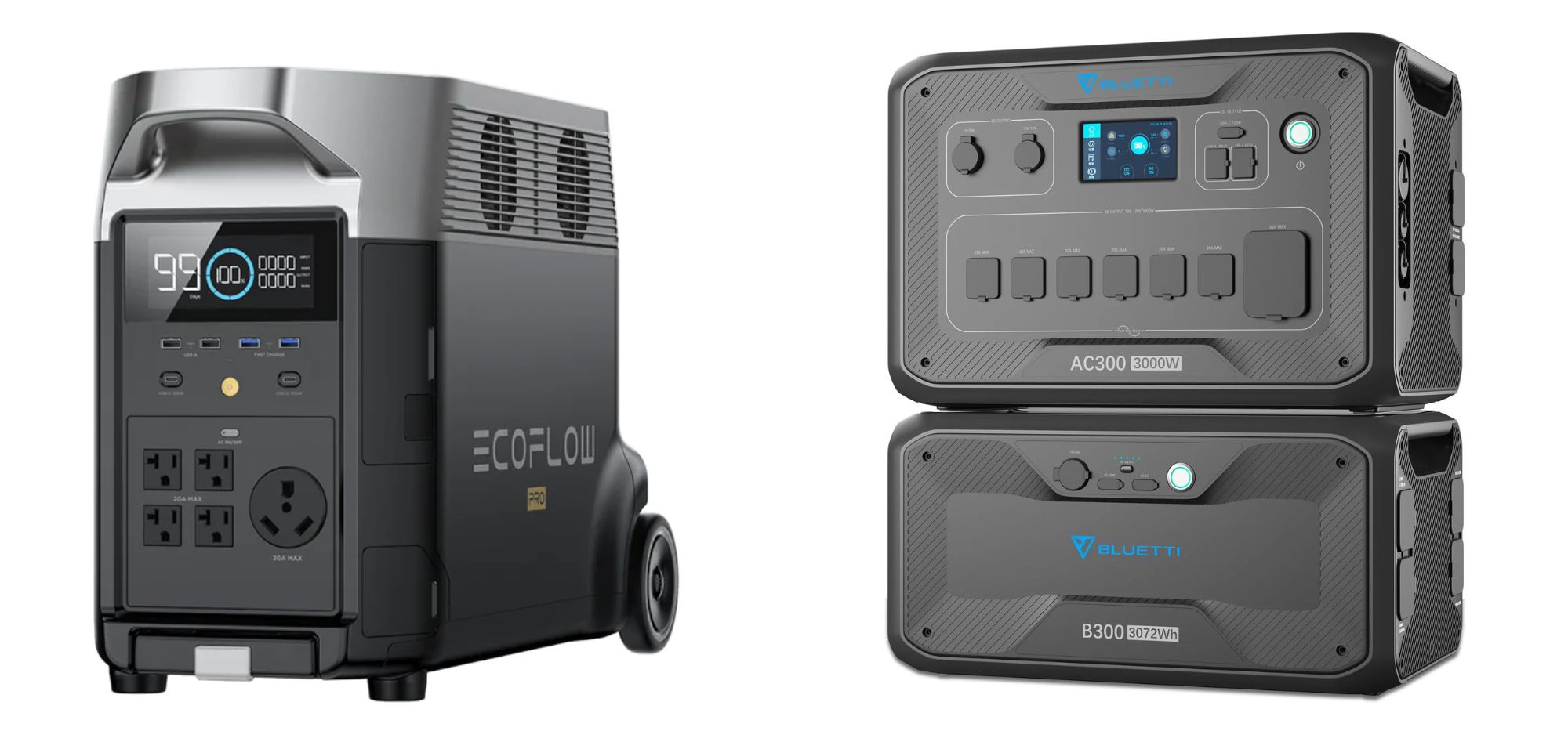
That means that you can charge up to 17 devices using the 14 ports on the AC300 and the 3 ports on the B300.
| Bluetti AC300 + B300 | EcoFlow Delta Pro | |
| Output Ports | 17 ports combined:
14 ports on the AC300 3 ports on the B300 |
15 Ports |
| AC Power Ports | 6 ports (AC300): 120V, 20A
1 port (AC300): 120V, 30A 3000W in total |
5 Ports: 230V, 50/60Hz
3600W in total |
| USB-A Ports | 2 ports (AC300): 5V, 3A (15W max per port)
2 ports (AC300): 3.6-12V, 3A (18W max per port) 1 port (B300): 18W |
2 ports: 5V, 2.4A, 12W Max per port
2 ports: 5V, 2.4A / 9V, 2A / 12V, 1.5A, 18W Max per port) |
| USB-C Ports | 1 port (AC300): 100W max
1 port (B300): 100W max |
2 ports: 100W Max per port |
| Car Power output | 1 port (AC300): 24V, 10A
1 port (B300): 12V, 10A |
1 port: 12.6V, 10A |
| DC Output | 1 RV port (AC300): 12V, 30A | 2 ports: 12.6V, 3A (38W Max per port) |
| Anderson Port | No port | 1 port: 12V, 30A |
| Wireless Charging Pads | 2 Pads | 0 Pads |
| Wireless charging | 2 Pads (AC300): 15W max for each | |
| Input Ports | 6 ports combined:
3 ports on the AC300 3 ports on the B300 |
3 Ports |
| AC Charging Input | 1 input (AC300): 3000W max
1 input (B300): 500W max |
1 port: 120V, 15A / 240V, 12.5 A (3000W max) |
| Solar Charging Input | 1 port (AC300): 2400W max
1 port (B300): 200W max |
1 port: 11-150VDC, 15A Max (1600W max) |
| Car Charging Input | 1 port (AC300):12/24V, 8A
1 port (B300):12/24V, 8A |
1 port: 12/24V, 8A |
Battery capacity and power
The Delta Pro boasts an impressive capacity of 3600Wh, while the AC300 + B300 has a capacity of 3072Wh. Both stations are expandable, with the Delta Pro maxing out at 25kWh, and the AC300 + B300 up to 12.3kWh.
In terms of power, the Delta Pro is more powerful and able to generate a maximum continuous power of 3600W, compared to the AC300 + B300’s 3000W.
| Bluetti AC300 + B300 | EcoFlow Delta Pro | |
| Battery Capacity | 3072Wh | 3600Wh |
| Max Continuous Power | 3000W | 3600W |
| Surge Power | 6000W | 7200W |
| Expandable Battery | Yes: (3.0kWh, 6.1kWh, 9.2kWh, 12.3kWh) | Yes: (3.6kWh, 7.2kWh, 10.8kWh, 12.5kWh, 25kWh) |
| Operating Temperature | -4°F to 104°F / -20°C to 40°C | 14°F to 113°F / -10°C to 45°C |
| Lifecycle | 3500+ Cycles to 80% Original Capacity | 6,500 cycles to 50% capacity, 3,500 cycles to 80% capacity |
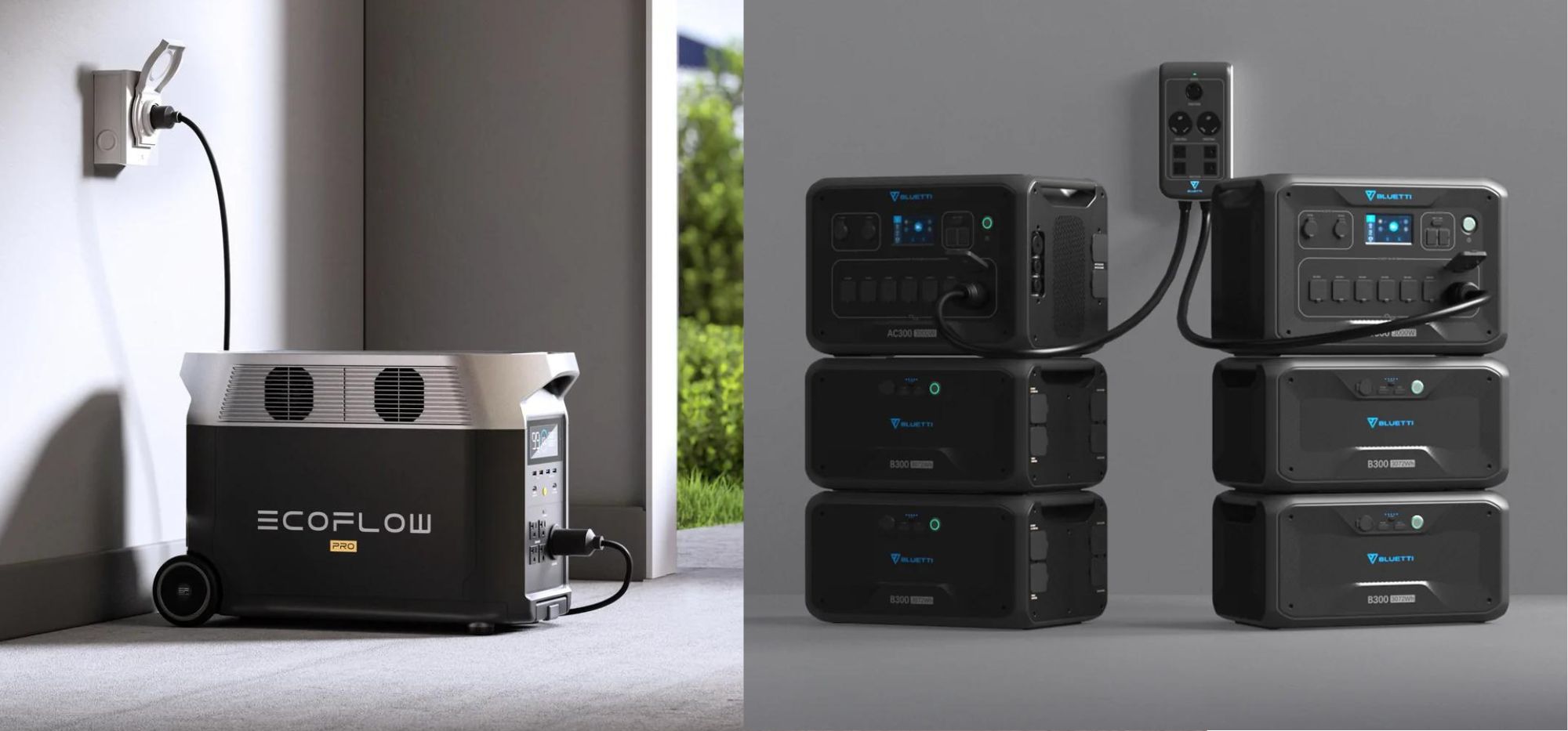
Recharge Time
The EcoFlow Delta pro will charge faster out of the box, taking about 2.7 hours using a regular 1800W output. Increase the wattage to 3000W and you can get a full charge in 1.8 hours.
The AC300 + B300 takes about 6.5-7 hrs with a 500W input, but if you opt for the 30A AC charging cable that supports 3000W, you can reduce the charging time to 1.5 hours.
| Bluetti AC300 + B300 | EcoFlow Delta Pro | |
| AC Input | 6.5-7hrs (500W) / Approx 1.5 hrs (3000W) | 2.7 hrs (1800W) / 1.9hrs (2900W) / 1.8hrs (3000W) |
| Solar Input | 15.5-16hrs (200W) | 2.8-5.6 hours (1600W) |
| EV Charging | No EV charging option | 1.7 hours (3400W)
You will need an EV charging adapter sold separately. |
| Car Input | 30hrs (100W) / 15hrs (200W) | Approx 21 hours |
So, which is the better pick?
I would pick the EcoFlow Delta Pro simply because it offers more power, a higher capacity, and faster recharge times out of the box. And that’s not all. It’s more compact as a single unit, and the wheels make it easier to move around.
Don’t get me wrong. The AC300 + B300 is also a great choice as well and might be better for those looking for more port options. Since it also comes as two smaller units, it can be a good option if you want something more modular.
Whole Home / Industrial Range
Both Bluetti and Ecoflow have whole-home power solutions and can offer super high-capacity battery generators. They are expandable too.
They also have mobile/off-grid home power kits.
Ecoflow
Whole Home option: Delta Pro home bundle (can go up to 7200W and 21.6kWh)
Mobile/Off-grid Home Power Kits: Multiple options, customizable
Bluetti
Whole Home option: There are multiple options, EP500Pro is great. You can also get AC500 and add several batteries to expand it to 18.5kWh
Bluetti is releasing their new EP900 with B500 batteries. This is specifically for home/office purpose and can be used as a UPS.
Hope we were able to help you make your decision. You can also check out some of our other comparisons

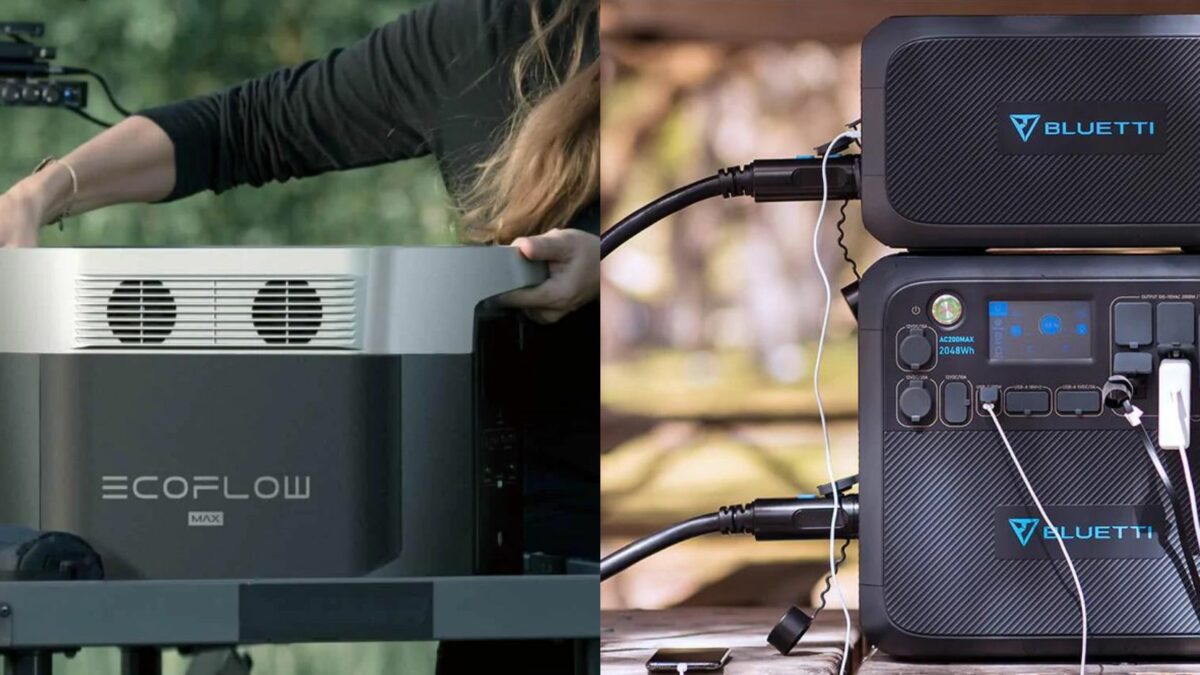
This is a helpful article. Thank you!
You can use two bricks for Bluetti AP200 to improve the AC charging speed. I got about 920wh and it fully charged the battery from 0% to 100% in 2 hours or so. However, it is still inconvenient to bring the bricks around.
Thanks for the tip
I live in Newport Beach, Calif. Where can I get a demo on the EcoFlow solar Generators
I don’t know if Ecoflow has a physical store but you might be able to find them at Home Depot. If not, I would shoot Ecoflow an email, they might be able to set you up with something
No, because the bluetti you can recharge it also via solar, which will output more than ac charging via the brick that comes with the unit. So probably via solar both units will have the same charging capacity
Can you comment in the difference between the two in terms of sound levels? When using these units in confined spaces, potentially running for long periods of time, it would really help to know how loud they are. Thanks!
How loud are these units? Weight comparisons?
Great review. Totally agree with Freddy regarding charge times. Sorry there was no mention of how loud these units are when running.
The recharge time stands out more than anything 1.8 hours for the delta to fully recharge and 10 hours for the eb150 that is a ridiculous difference and if it charges that slowly being plugged in then there is no way the solar charging option would be able to keep up and if the power went out due to storm for extended time the Eb150 would be rendered useless do to the long recharge time required